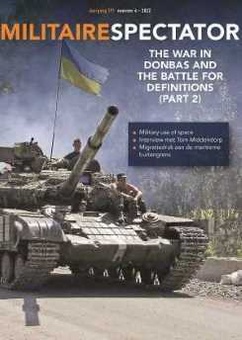The conclusion of the first part of this article was that, when adhering to the phrase hybrid warfare in order to describe the violent conduct of war, the concept as defined by Frank Hoffman offers the best framework for analysing the Donbas War. This second part elaborates on that conclusion by translating the concept of hybrid warfare into features and search for these within the actual conduct of hostilities, in order to determine to what extent the 2014-2015 Donbas War can truly be considered a hybrid war, while at the same time providing a detailed description of the combat operations.[1]
Characteristics of hybrid warfare
In order to qualify as a hybrid opponent, irregular forces need to be capable of deploying and operating conventional weapon systems, subsequently blending different modes and methods of warfare. These actions, or even units, need to be tactically or operationally integrated or at least directed and coordinated within the main battlespace in order to achieve synergistic effects. The main aspects of a hybrid opponent therefore concern its composition and organization, as well as its means and the skills to successfully operate these means, translated into capabilities. Not surprisingly, one of the main causes for the rise of hybrid warfare is the enhanced access to advanced conventional capabilities for irregular opponents as a result of globalisation and technological advancements. Enabling a hybrid opponent to shift back and forth between irregular and conventional methods, or even to use them simultaneously, depending on the situation. In doing so, hybrid forces create a dilemma for conventional adversaries because in order to cope with a guerrilla war a conventional force has to disperse, while defending itself against a conventional assault compels it to concentrate.[2]
Irregular forces usually tend to be more loosely organized, while conventional forces mostly have some uniformity in accordance with regular military organisational structures. Another significant indication is the availability of technologically advanced weapon systems that require a high degree of training to operate. As a result of these increased capabilities, a hybrid opponent will no longer feel the need to constantly retreat further into inaccessible terrain such as forests, mountains and built-up areas. The resulting nature of the fighting will therefore become more continuous compared to irregular warfare, as hit-and-run tactics will give way to more prolonged confrontations. The intensity of the fighting will also increase accordingly as a result of the deployment and integration of more and heavier weapons, resulting in higher casualties. As the scale, intensity and overall complexity of the operations increase, so will the necessary degree of command, control and coordination, for which the presence of more senior military personnel, specialized communication equipment and localized headquarters can provide important indications.
Finally, the battlespace consists of both physical and non-physical environments. Whereas physical environments can be outlined through geographical borders, non-physical environments cannot. For the purpose of this article, the battlespace, including the electromagnetic spectrum, will be confined geographically to the boundaries of Donetsk and Luhansk Oblasts, situated in Eastern Ukraine.[3] With regard to the information environment, information operations conducted outside the boundaries of the physical battlespace will also be considered part of the applied definition of hybrid warfare as long as they are synchronised with operations taking place within the main battlespace.
Containment
Almost immediately after the little green men appeared in Crimea, which led to its official annexation by Russia on 18 March 2014, protests against the new Ukrainian government erupted across Eastern Ukraine, where the majority of the population is of Russian ethnicity and economically and culturally strongly connected to Moscow. Promptly a number of self-proclaimed mayors and governors came to the fore, presenting themselves as leaders of these protesters and demanding federalization and greater autonomy from Kiev. When Ukrainian security forces entered the scene and removed these so-called mayors and governors, they unintentionally cleared the way for more dangerous chieftains to take over.[4] These new leaders, most of whom had considerable military experience, brought with them extensive networks, including ties with the Russian intelligence- and security services. Men like Valeriy Bolotov, Aleskandr Boroday and Igor Girkin, better known under his nom du guerre Igor ‘Strelkov’.[5] Some were even connected to local Donbas veteran organizations, providing them with an extensive regional network to tap into.[6] Under their leadership the separatist movement began to take shape in earnest and soon moved towards an armed insurrection, changing the separatists’ aim from gaining more autonomy from Kiev into achieving complete secession from Ukraine and accession to Russia.
Between 6 and 23 April several armed separatists groups, like the one under Girkin, seized administrative buildings in a number of East-Ukrainian cities. This was followed by the proclamation of the Donetsk People’s Republic (DPR), on 7 April, and the Luhansk People’s Republic (LPR) several weeks later.[7] Its fighters demonstrated a high degree of professionalism and military capabilities, clearly recognisable by such things as a disciplined attitude, advanced military equipment and something as elementary as superior weapon handling skills. The fighters of these republics demonstrated a high degree of professionalism and military capabilities, clearly recognisable due to their disciplined attitude, advanced military equipment and elementary skills such as superior weapon handling.[8] These were clearly not militants without prior military training and were probably supported by covertly operating Spetsnaz special forces from Russia,[9] presumably intended to train local recruits and help organize the separatist forces.[10] Groups like these initiated hostilities and formed the driving force behind the armed insurrection. Girkin was soon able to unify a large part of the separatist fighters under his command. Meanwhile, a number of local weapon depots were captured, providing the rebel groups with enough small arms to back up their separatist claims.[11] These were then distributed among local anti-Maidan protesters gathering outside, a method that was used across cities in Donetsk and Luhansk Oblasts throughout April in order to fuel the insurrection which started to expand rapidly.[12]
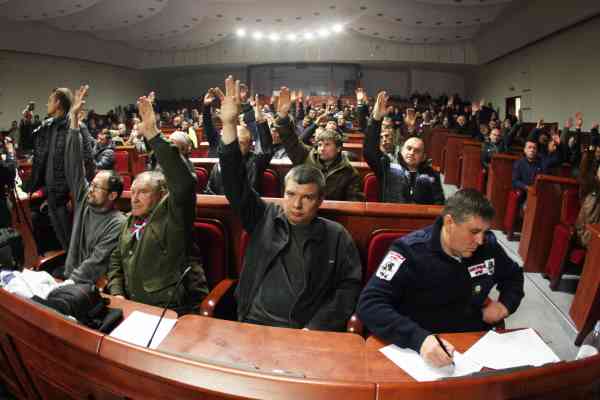
After armed separists’ groups seized main administration buildings, pro-Russian activists in the eastern Ukrainian city of Donetsk proclaim the creation of a sovereign people’s republic on April 7, 2014. Photo ANP/AFP, Alexander Khudoteply
During this initial phase, separatist forces consisted largely of local fighters, augmented by mercenaries and an initial batch of volunteers from Russia.[13] Many of these local militia members were actively engaged in criminal activities or even members of criminal organizations.[14] Additionally, various Cossack militias became involved, returning to their traditional military role as auxiliaries in support of the Russian army.[15] Although the role of Private Military Companies (PMC) would grow as the conflict advanced over the course of the year, the first mercenaries belonging to Wagner Group did not cross the border until 21 May. That day two company-sized formations named ‘Luna’ and ‘Step’ crossed the border and entered Luhansk Oblast. The nucleus of these units comprised former members of the GRU, supplemented by well-trained, well-equipped and experienced mercenaries.[16] This again indicates that Russian security and intelligence services made extensive use of informal networks comprising largely of former employees. While all this was taking place within Eastern-Ukraine, Russia was massing up to 40,000 troops along the Ukrainian border in order to deter a strong Ukrainian military response by threatening to escalate the conflict.[17] As would soon become apparent, this did not have the desired effect. On 12 April the Ukrainian high command launched the Anti-Terrorist Operation (ATO) and security forces rushed in to seal off and recapture the separatist strongholds. Meanwhile, Kiev conducted a large-scale mobilization in order to bring the army up to the required troop level. Although the Ukrainian army officially numbered 130,000 men, in reality, due to long-term neglect of the armed forces, it was scarcely able to put 6,000 soldiers in the field.[18] Therefore, in order to bolster the regular army during this initial phase, a number of volunteer battalions were hastily formed, which would be a crucial addition to the regular army during the upcoming offensives.[19] During this initial stage, however, Ukrainian forces proved largely unable to muster sufficient means to effectively combat the separatists’ strongholds, especially as the latter had been able to capture a number of heavy weapons.[20] Besides, most of the available Ukrainian forces were dispatched elsewhere to secure critical infrastructure from capture or destruction by the separatists and towards the border in order to prevent the separatists from receiving further reinforcements from Russia.[21] Russian military support by way of providing weaponry was still very limited at this stage.[22] Advanced and heavy weapons that would render the irregular separatists forces conventional capabilities, a key indicator of hybrid warfare, were still completely absent. The Russians did engage in information warfare, for example by using social media platforms like VKontakte and Odnoklassniki, as well as through local Russian language media outlets with the aim to influence the conflict narrative and obtain support for the separatists’ cause. However, these efforts were not integrated into the overall conduct of the operation in the Donbas, placing them outside the established boundaries of hybrid warfare.[23] Considering the limited amount of Ukrainian troops available and the, still, irregular nature of the separatist forces, it is not surprising that it remained a low-intensity conflict during this stage.[24] The fighting was characterized by sporadic and relatively small-scale engagements, which clearly indicates the limited size of the units involved.[25]
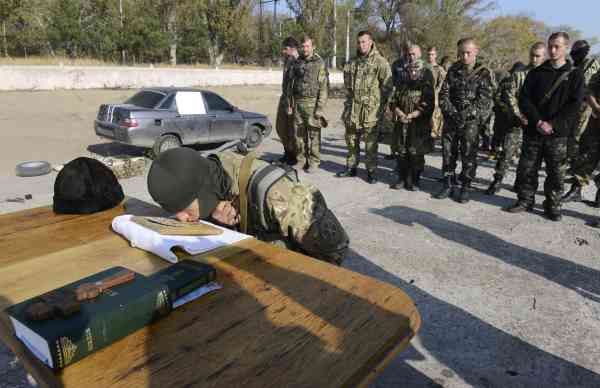
Servicemen of the Ukrainain St. Maria battalion attend a prayer on their base in Mariupol, Eastern Ukraine, October 2014; although the Ukrainian Army officially numbered 130,000 men, it was scarcely able to put 6,000 soldiers in the field. Photo ANP/AFP, Alexander Khudoteply
The concurrent use of Russian and non-Russian paramilitary units, Private Military Companies and other proxy forces, as well as the deployment of special operations forces and use of the protest potential of the local population, was fully in line with the Russian military doctrine of 2014.[26] Additionally, the ostensibly simultaneous seizure of key administrative buildings in the cities of Donetsk, Luhansk and Kharkov may indicate some form of higher-level coordination.[27] While Russia probably wasn’t the instigator of the initial protests it does seem likely that it further fuelled the insurrection, indicating at least some higher level involvement. Nonetheless, later that year, in two interviews, Girkin recounted the chaos that reigned in Donetsk at that time, describing several militant groups all clearly operating independently from each other.[28]
Given this description, it seems unlikely that the uprising at this stage was tactically and operationally coordinated or directed within the main battlespace in the manner Hofmann intended. With regards to the composition and organization of the separatist forces, they were still very loosely organized in an irregular fashion, lacking advanced and heavy weaponry and thus limiting their conventional capabilities. Accordingly, the fighting remained rather small-scale and of limited duration and intensity. For these reasons, this initial phase cannot be defined as hybrid.
Counter-offensive
It soon became evident that the separatist cause did not attain as much local support as they had hoped. Moreover, their influence and span of control was limited to only a number of towns and cities. Around mid-May the separatists became desperate for further reinforcements, calling on ever more local civilians to join their forces.[29] Meanwhile, conscription in Ukraine had been reinstated by the end of May and a series of mobilizations had called up more than a hundred thousand reservists to help fill the ranks. Numerous new army units were created, along with 27 territorial defence battalions.[30] These were used to cordon off territories, enable regular army formations together with over 50 volunteer units to conduct the planned counter-offensive, the aim of which was threefold. First, to eliminate those separatist strongholds which did not receive sufficient support from the local population; second, to capture the border region with Russia, thereby reducing the influx of weapons and fighters from Russia; third, to physically separate the two breakaway republics from each other.
The first sign that the momentum was changing in favour of Ukraine came when around 200 separatist fighters, including members of the infamous Vostok battalion, suddenly stormed and captured Donetsk Airport, on May 26.[31] The Ukrainian response was swift and decisive when a unit of Ukrainian paratroopers was brought in who, with the support of helicopter gunships, were able to recapture the airport the following day[32] while inflicting heavy casualties upon the separatist forces.[33] Thereafter, the Ukrainian counteroffensive gathered steam and the fighting further intensified. What followed was the recapture of Slovyansk and Kramatorsk, which forced Girkin and his estimated 1,500 fighters to retreat to Donetsk.[34] After Mariupol was reoccupied on 13 June the centre of gravity then shifted towards the border with Russia. It was becoming clear that the separatists were unable to cope with the reinforced Ukrainian army and that without more Russian support the insurrection was soon to collapse. Certain documents related to a Russian operations plan that emerged in June 2015 indicated that a full-scale invasion of Eastern Ukraine might also have been considered as a possible course of action by the Kremlin during this period.[35] In the end, though, the Kremlin chose a different option, following a more covert and indirect approach instead, gradually bringing in conventional capabilities to further strengthen the separatist forces.
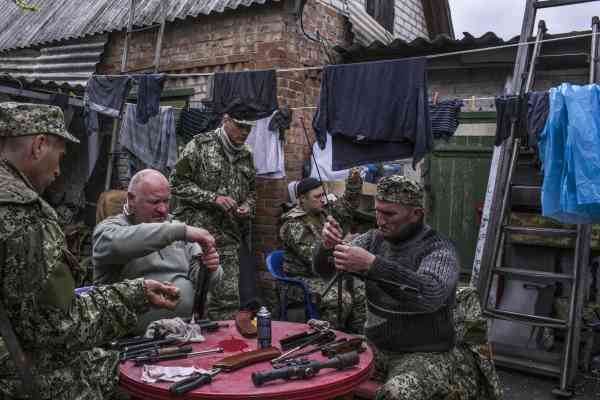
Pro-Russian militiamen, part of the self-proclaimed Donetsk People’s Republic, clean weapons at their camp in Slovyansk, Ukraine, April 2014. Photo ANP/The New York Times, Mauricio Lima
From the end of May, Russia started to increase its recruitment efforts in order to bolster the separatist ranks. This was done particularly by tracking down numerous Russian veterans of the wars in Chechnya, Georgia and even Afghanistan, but also young Russian men who had just recently finished their military service. Attracted by the promise of substantial compensation, many answered the call. Among them were men with a significant amount of combat experience, or at least had knowledge of how to operate the growing amount of heavy and complex weapon systems that would soon be finding their way into the conflict zone. On route to the Donbas, most of these volunteers travelled through training camps in Rostov and Belgorod oblasts, situated along the border, where they received training and weaponry and were stripped of everything that could trace them back to Russia.[36] As Russia’s involvement grew over time, so did the camps, ultimately housing thousands of regular Russian soldiers in support of the operation.[37] Once the volunteers crossed the border into Ukraine, they were used to replenish the various separatist militia formations. As a result of these measures, according to Ukrainian estimates, by 16 June the number of separatist fighters in Eastern Ukraine had risen to approximately 20,000, presumably around half of whom were from the Russian Federation.[38] Consequently, these reinforcements brought with them a considerable amount of knowledge and experience regarding conventional warfare capabilities in order to supplement the existing irregular separatist forces.
Around the same time, significant amounts of heavy weaponry began to appear on the scene. By supplying only Soviet-era weapons, also in use by the Ukrainian army, to the separatists it remained possible for Russia to retain plausible deniability regarding Russian involvement, asserting that these were weapons captured from the Ukrainian army. From 12 June onwards, T-64 tanks started to appear in Eastern Ukraine in ever-increasing numbers.[39] Artillery pieces, such as D-30 towed howitzers, 2S1 Gvosdika self-propelled howitzers and BM-21 Grad multiple launch rocket systems (MLRS), also began to arrive in large quantities as well as a considerable number of armored vehicles, like various BMP infantry fighting vehicle- and BTR armoured personnel carrier variants.[40] Russia also began supplying the separatists with more advanced weaponry, including numerous Surface-to-Air Missiles (SAM), including the Soviet-era 9K32 Strela and 9K38 Igla, but also more sophisticated air defence systems like the 9K33 Osa, 9K35 Strela-10M and 9K35 Buk-M1. These systems enabled the separatists to target aircraft flying at medium- and higher range altitudes. This resulted in several Ukrainian aircraft being shot down, after which the Ukrainian Airforce more or less withdrew from the conflict zone.[41] Of course the greatest tragedy occurred on 17 July, when flight Malaysia Airlines MH17 was shot down over Ukrainian territory with a Buk-M1 missile belonging to Russia’s 53rd Anti-Aircraft Missile Brigade.
During the early morning hours of 11 July a Russian UAV spotted the equivalent of three Ukrainian battalions gathered in a Tactical Assembly Area (TAA) near the village of Zelenopillya, close to the border with Russia. What followed was a massive rocket artillery strike conducted from inside Russian territory, using a combination of high explosive, thermobaric and top-attack munitions, resulting in 30 Ukrainian soldiers killed while wounding up to a hundred and destroying approximately two battalions worth of vehicles and equipment.[42] From then on these cross-border artillery strikes continued throughout the summer months, wreaking havoc upon Ukrainian formations.[43] This finally resulted in the Ukrainian army abandoning their attempts to capture the border region and, instead, shifting its centre of gravity to physically separating the Luhansk and Donetsk republics from one another.
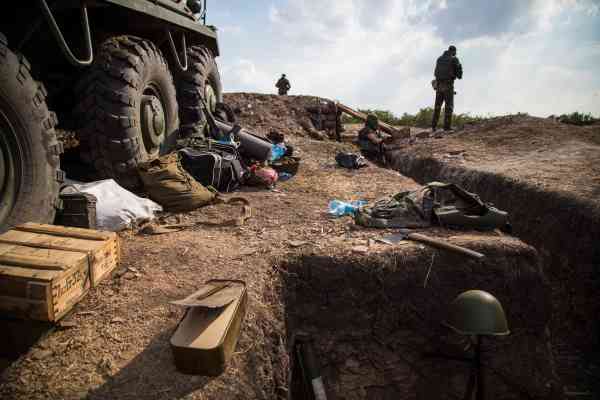
Ukrainian servicemen wait at a trench on the frontline not far from Debaltseve in the Donetsk region, August 2014. Photo ANP/AFP, Oleksandr Ratushniak
This switch in strategy was initiated by what has become known as ‘Zabrodski’s Raid,’ during which colonel Mikhailo Zabrodski led his strongly reinforced 95th Air Assault Brigade in a daring armoured raid over a distance of 200 kilometres behind enemy lines. On 28 July the important railroad hub of Debaltseve, located in between the two republics, was recaptured. Thereafter the Ukrainian army continued its advance towards the city of Ilovaisk and the general direction of the border with Russia, conducting a deliberate campaign through systematically and gradually isolating and capturing separatist strongholds. An initial attempt to retake Ilovaisk was repelled by strong separatist opposition. Then, on 18 August, the Ukrainians renewed their assault, this time conducted by multiple volunteer battalions supported by tanks. As opposition stiffened, however, it soon became bogged down in protracted and costly house-to-house fighting.[44] Meanwhile, the Ukrainian paratroopers who had been defending Luhansk Airport since early April, fighting a positional siege-style war, were also confronted by an increasingly superior opponent using ever larger amounts of heavy artillery.[45]
As Russian personnel and material support grew in size, so did the Kremlin’s need to establish its control over the fighting. The arrival of the Vostok battalion was seen by many analysts as a means to ascertain control over the largely independently operating and rogue militias.[46] On 29 May, just two days after they first appeared on the scene during the fighting for Donetsk Airport, members of the Vostok battalion raided the administrative buildings in Donetsk clearing them from some of the separatist leaders Moscow viewed as criminals and who had occupied the buildings since the beginning of April. The whole operation was repeated in Luhansk several days later where another Moscow associate gained control.[47] As a result, around mid-August, the Russian-born Girkin and Boroday were both relieved of their commands and replaced by local separatist leaders.
At the same time there were several indications that the information warfare campaign was by now also becoming fully integrated in the ground operations. On 9 June a Russian news site, known for previously spreading disinformation, reported on separatists capturing three T-64 tanks, three whole days before these particular tanks actually rolled into Ukraine.[48] The same applies to the Buk-M1 air defence missile system that shot down flight MH17 on 17 July. More than two weeks earlier, on 29 June, a Russian state television network run by the Ministry of Defence reported on the alleged capture of a Buk system from the Ukrainian army, which was not confirmed by any other source or media channel.[49] In addition to this, as a result of increased Russian involvement, the separatists, as a fighting force, underwent an important transition, changing from being a disorderly body of irregular troops into a more organized composite proxy force combining irregular forces with significant conventional warfare capabilities. Especially the deployment of advanced weaponry like a Buk-M1 by a non-state actor serves as a prime example of a hybrid opponent in this regard. Although far from being able to fight a full-scale conventional war, the separatists at this stage did acquire enough capabilities to engage the now up to strength Ukrainian army on a somewhat more equal footing, at least at their own time and place of choice.
Clearly these indicators point out that by now the conflict had transformed in what can truly be referred to as hybrid with Russia to a significant degree establishing command and control and even integrating the information warfare campaign within the overall operations on the ground. While the separatists were receiving huge quantities of heavy- and advanced weaponry, their composition and organization began to change accordingly in order to translate these means into effective conventional capabilities. As a result, the engagements grew in both size and intensity and, consequently, the casualty rates increased significantly during this period.[50]
Intervention
Over the course of the previous months there were several isolated occasions in which regular Russian troops had already been engaged inside Ukrainian territory. However, these troops were still mainly small-sized Spetsnaz and reconnaissance elements. From 10 August onwards, both the number and size of such incursions started to increase, as did the resulting number of Russian casualties.[51] Finally, when a complete defeat of the separatists threatened to become inevitable, Russia decided to intervene directly by means of a large-scale ground offensive. Over the course of the summer, at least thirteen Russian Battalion Tactical Groups (BTG) and elements of five different Spetsnaz formations had been assembled along the border.[52] Then, on 24 August, six to eight Russian BTGs unexpectedly crossed the border into Eastern Ukraine.[53] Between 25 and 27 August the Ukrainian forces that were themselves in the process of capturing Ilovaisk, suddenly became surrounded by strong Russian forces. When they left the city under a supposed truce of arms on 30 August, they ran into well-prepared ambushes. The Russians subsequently destroyed the whole column, perhaps killing up to a thousand Ukrainian soldiers and capturing another 500.[54] It was the deadliest encounter of the war thus far and a clear sign of the ongoing escalation in both the level of violence and the amount of troops involved.
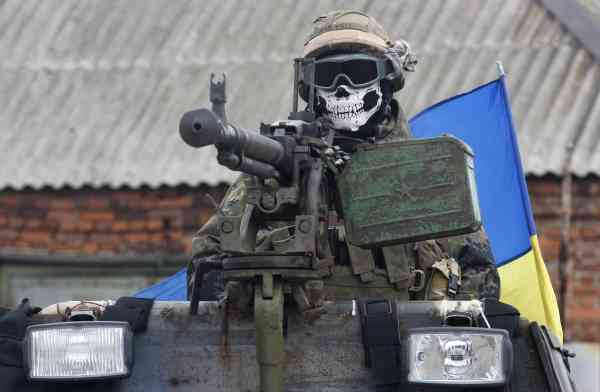
A Ukrainian armoured personnel carrier in a suburb of Debaltseve, September 23, 2014; according to the United Nations, the death toll of the conflict in Eastern Ukraine by that time had already soared past 3,000. Photo ANP/AFP, Anatolii Stepanov
Around the same time several Russian BTGs crossed the border near Rostov, situated along the Black Sea coast, heading towards the Ukrainian port city of Mariupol. A large tank battle occurred during which a Ukrainian armoured battalion of T-64s was engaged by Russian tanks, supposedly T-72B3s and T-90s. As a consequence, the Ukrainians were forced to withdraw towards the outskirts of Mariupol. While further north the prolonged encirclement of Ukrainian airborne troops in defence of Luhansk Airport finally came to an end after the Russians had brought in massive amounts of heavy artillery.
The signing of the Minsk I agreement created a temporary lull in the fighting and in the weeks that followed both Russian and separatist forces regrouped, with Russian troops returning to a supporting role and the separatists again operating as frontline units.[55] Then, on 28 September 2014, the second battle of Donetsk Airport began when separatist troops, supported by several Russian BTGs, launched coordinated attacks against the Ukrainian forces defending the airport. The battle again saw heavy tank clashes and large-scale deployment of artillery, resulting in the near total destruction of the airport. The fighting soon turned into positional warfare, with buildings changing hands repeatedly.[56] On 21 January 2015 the battle finally came to an end when the Russian-backed separatists finally dispelled the Ukrainians from the airport, ending the 240-day siege that had begun at the end of May the previous year.[57]
Immediately thereafter fighting around the city of Debaltseve erupted. For a long time this battle would remain the largest of the Donbas War until the recent full-scale Russian invasion of Ukraine on 24 February 2022. Two large strike groups had assembled on either side of the Debaltseve bulge, each consisting of multiple separatist brigades and supported by several Russian BTGs, perhaps totalling up to 19,000 men.[58] The Horlivka and Briankovska strike groups, as they were called, operated respectively from the south-western and north-easterly directions of the city. They acted as two pincers aiming to seal off the bulge and capturing the Ukrainian troops, numbering somewhere between 5,000 and 8,000 men, inside. The first phase of the battle lasted from 25 January until 2 February during which the separatists, despite massive artillery bombardments and repeated assaults, did not succeed in breaking through Ukrainian positions. A brief respite followed which was again used to bring in further reinforcements. The second phase of the battle began on 9 February when Russian troops succeeded in cutting the main supply route leading towards Artemivsk, finally encircling the remaining Ukrainian forces inside the city. The Minsk II agreement, which was planned to go into effect on 15 February, was conveniently disregarded by the separatists.[59] Under increasing pressure from artillery strikes and combined armoured and infantry assaults on their positions the Ukrainian defence perimeter finally started to crumble. When they eventually attempted a coordinated withdrawal in order to break out of the encirclement on the evening of 17 February, several Ukrainian columns again ran into Russian ambushes, repeating the Ilovaisk disaster on a comparative scale. The battle of Debaltseve marked both the high mark and the end of large-scale combat operations in Eastern Ukraine. Thereafter, for the next couple of years to come, the conflict degenerated into a general stalemate, incidentally interrupted by relatively minor skirmishes.
What these developments demonstrated was that the Russian approach of supplementing the irregular separatist forces with limited conventional support, lasting from May till August, had proven insufficient. Only by intervening with significant numbers of regular Russian troops were they able to prevent the separatists from succumbing to Ukrainian military pressure. At the time of the incursion, the total number of Russian troops inside Ukrainian territory probably numbered somewhere between 3,500 and 6,500, rising to approximately 10,000 by the end of the year. Eight of Russia’s ten field armies ultimately contributed to the operations in Donbas, originating from all of Russia’s military districts at the time.[60] In order to generate the necessary number of deployable units, Russian field units were ordered to establish BTGs, usually one per brigade- or division-level formation.[61] These were then rotated through the conflict zone, enabling almost the entire Russian army to gain combat experience.
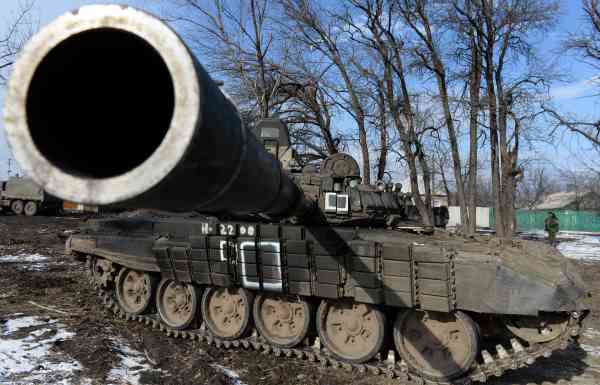
A T-72 tank of pro-Russian rebels is posted outside Uglegorsk, 6 kilometres southwest of Debaltseve, on February 19, 2015; the ever-increasing number of tanks and other weapon systems meant that the separatists were increasingly transforming into a conventional fighting force. Photo ANP/AFP, Vasily Maximov
Although Russia attempted to transform the separatists militias into conventional armed forces they were initially only partially successful in doing so. While many separatist formations were renamed using typical Russian unit designations, these were not arranged by a standard organizational structure.[62] Nevertheless, most of these larger formations were equipped with their own organic fire support assets and in time would even deploy their own tank battalions. This is a strong indication that these units that had until recently been irregular formations were gradually moving towards conventional warfare.[63] During the Battle of Debaltseve, many of the above mentioned brigades and battalions were even grouped into what might be seen as operational level formations, the epitome of large-scale conventional warfare.[64] Since then, the assorted collection of separatist units have been reformed and brought together into a conventional force based on a regular military organizational structure, known as the Donetsk People’s Army’s (DPA) Ist and Luhansk People’s Army’s (LPA) IInd army corps.[65]
When regular Russian army formations began crossing the border en masse, they brought with them an extensive arsenal of conventional military hardware. EW assets were used to suppress Ukrainian communication systems by jamming radio communications, cellular phone networks, UAV data links and spoofing GPS signals. Even Russian early warning aircraft were deployed at greater distances, operating from inside Russian airspace. Additionally, several radar systems were deployed as early warning against incoming Ukrainian artillery fire and directing counter battery fire.[66] The numbers and different types of UAVs that were deployed and used for reconnaissance and target identification also increased dramatically.[67] Russia also deployed some its most advanced MLRSs and largest artillery systems.[68] Nevertheless, the weapon system that came to symbolize the extent of Russian involvement the most was undoubtedly the tank, specifically the Russian built T-72B3 and T-90s that were not in use by the Ukrainian army. The ever-increasing number of these weapons, be it tanks, radars, MLRS or any other system, together with the organisational changes, meant that the separatists were increasingly transforming into a conventional fighting force.
All the major battles that occurred during this phase displayed the same characteristics. Ilovaisk and Debaltseve were classic encirclement battles conducted by combined arms formations, resulting in protracted siege-style warfare with infantry engaging in intense house-to-house fighting while being supported by tanks and large amounts of artillery. The same accounts for the battles of Luhansk and Donetsk airports, where the fighting, sometimes at extreme close quarters, continued for several months.[69] There were also a number of tank duels at a scale that had not happened in Europe since the Second World War. Several times the deployment of tanks even had a decisive impact on the outcome of the battle.[70] These are all clear indications of the increasingly conventional nature that characterised the fighting during this phase.[71]
Looking at the increased number and technologically advanced state of these weapon systems, as well as the manner in which these were deployed, it seems clear that these were by no means still the ill-orchestrated militias that Girkin faced when he arrived in Donetsk the previous year. The level of training necessary to operate these systems is not something that can be acquired in a limited amount of time, especially when these systems require a high degree of cooperation and coordination. Most sources indicate that the operational headquarters for coordinating the separatist campaign in Eastern Ukraine was located at Southern Military District headquarters in Rostov-on-Don, from which most units operating in Donbas originated.[72] It is also possible that this headquarters served as the primary link between the operations in Donbas and Russia’s military and political leadership seated in Moscow and that 49th Army headquarters in Stravropol was responsible for coordinating the actual combat operations on the ground.[73] Additionally, the city of Krasnodon, while situated on the Ukrainian side of the border, seems to have functioned as the primary coordination centre for the movements of both separatist and regular Russian detachments into Ukraine.[74]
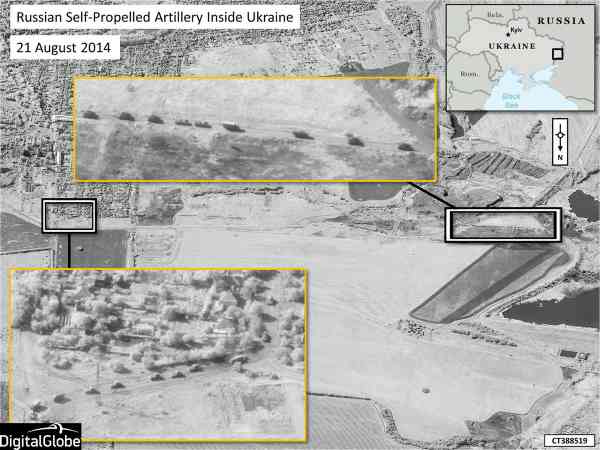
A NATO handout dated 28 August 2014, said to show a Russian artillery column on Ukrainian soil near Krasnodon; from 24 August onwards the Russian military involvement signalled a transition from hybrid to conventional warfare. Photo Digital Globe/DPA
Apart from the location of the tactical and operational headquarters, there were other indications that Moscow was by now firmly in control of the conduct of military operations inside Donbas. One such instance was the alleged sighting of a Russian general by the name of Aleksandr Lentsov in Debaltseve on 17 February, the very day the remaining Ukrainian forces in the city started their withdrawal. The sight of this Russian general immediately instigated rumours that he was leading the capture of Debaltseve.[75] Another plausible indication was the sighting, inside the village of Lohvynovo during the second phase of the battle, of an R-166-0.5 radio station, which is a system that is capable of establishing secure radio communications over distances up to 1,000 kilometres. The fact that a Russian radio system with these capabilities was spotted inside Ukraine, especially during the greatest battle to date, is likely to indicate that some form of command and control over the operations in Donbas came from inside Russian territory.[76]
Besides establishing tactical and operational command and control in the Donbas, it is clear that from 24 August onwards the Russian military involvement signalled a transition from hybrid to conventional warfare. Likewise, as a result of the seemingly unlimited influx of advanced- and heavy weapons, the composition and organization of the separatist units slowly but steadily transformed into conventional fighting forces. Subsequently these increased capabilities resulted in classic high-intensity warfare, characteristic of conventional armies, resulting in an ever-increasing number of casualties.
Conclusion
Looking back at the core element of hybrid warfare, i.e. the blending of different modes of warfare through combining irregular forces with conventional capabilities, it is clear that during the first phase of the armed conflict the separatists in the Luhansk and Donetsk breakaway republics formed a purely irregular fighting force, which subsequently resulted in sporadic and relatively small-scale skirmishes. When protests erupted across the Donbas region, the Russians, in all likelihood, recognized a potentially favourable situation and decided to act upon it by fuelling an already flammable situation. Although Russia was engaging the local population through information warfare at this time, this was not coordinated with actions actually taking place inside Ukraine. Additionally, there appears to have been little or no coordination between the various separatist detachments during this initial period.
Things changed when it became clear that without additional Russian support the insurrection would soon collapse. This forced Russia to raise the stakes by stepping up the level of involvement in order to achieve its objectives at a minimum cost while still retaining a certain degree of plausible deniability. Only then did the Russians step up their efforts by increasing the personnel and material support to the separatists. It was during this second phase, lasting from the First Battle of Donetsk Airport on 26 May until the start of the Russian invasion on 24 August, that the separatist forces can truly be regarded as a hybrid opponent and the resulting fighting as a form of hybrid warfare. It also saw Moscow increasing its control to get a grip on a situation that clearly did not develop in the directions it had initially intended. In this period the separatist forces composition started to include large numbers of advanced and heavy conventional weapon systems. Simultaneously, their formerly irregular organization began to transform to include these newly-acquired capabilities as well as the level of training necessary to operate these systems. These factors combined temporarily resulted in the blending of different modes and methods of warfare. Consequently, the engagements grew in both size and intensity and the casualty numbers increased accordingly.
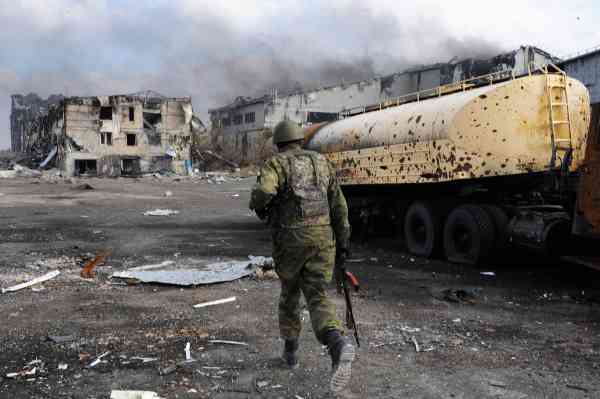
A Pro-Russian separatist soldier during the Second Battle of Donetsk Airport during a shelling between Ukrainian army forces and pro-Russian separatists on October 16, 2014; the DPA’s Somali, Sparta and Vostok battalions, supported by Russian regular formations, conducted a large scale assault supported by massive salvo’s of artillery fire to cover their advance. Photo ANP/AFP, Dominique Faget
Ultimately, however, the hybrid approach was not enough to stem the Ukrainian advance. So, at the end of August Russia probably saw no other option than to decide to intervene by means of a full-scale military intervention by regular Russian forces. As a result, the nature of the fighting took a definitive transformative step into the direction of conventional warfare. With the separatist forces becoming more organized and equipped along conventional lines, these developments led to a number of conventional set-piece battles, all resulting in major Ukrainian defeats. By now, the Russian military was firmly in control of combat operations in Eastern Ukraine, which also saw a further integration with Russia’s ongoing information campaign.
In conclusion, therefore, the only phase of the Donbas War that can actually be considered as hybrid warfare according to the 2007 definition of Frank Hoffman is the period lasting from the end of May until the end of August 2014. It was only during this second phase of the war that the irregular separatist fighters acquired the necessary conventional capabilities that together form the key ingredients of hybrid warfare, while enhanced Russian command and control enabled them to blend and coordinate these different modes and methods within the same battlespace. Thereafter, following the Russian intervention in August the nature of the fighting further transformed along conventional lines into short and sharp all-out war before transcending into stalemate, until Russia’s full-scale invasion of Ukraine on 24 February 2022.
[1] For a detailed description of the definition of hybrid war according to Frank Hoffman, see the first part of this article: Randy Noorman, ‘The war in Donbas and the battle for definitions. Part 1: The problem with hybrid warfare’, Militaire Spectator 191 (2022) (3) 140-153.
[2] This element characterized the Vietnam War on a strategic level, referred to as a compound war by Frank Hoffman. See part one of this article: Hoffman, Conflict in the 21st Century: the Rise of Hybrid Wars, 21.
[3] Renamed by the separatists as the Donetsk- and Luhansk Peoples Republics (DPR and LPR).
[4] Michael Kofman et al, Lessons From Russia’s Operations in Crimea and Eastern Ukraine (Santa Monica, RAND Corporation, 2017) 33-37. See: https://www.rand.org/pubs/research_reports/RR1498.html.
[5] Igor Girkin, allegedly a former Federal Security Service (FSB) officer and citizen of the Russian Federation, is one of the four suspects held responsible for the downing of flight MH17 on July 17th 2014.
[6] Nikolay Mitrokhin, ‘Infiltration, Instruction, Invasion: Russia’s War in the Donbas,’ translated from German in Osteuropa No. 8 (2014) 223-224. See: https://ibidem-verlag.de/pdf/07-mitrokhin.pdf.
[7] Kofman et al, Lessons From Russia’s Operations in Crimea and Eastern Ukraine, 38-40.
[8] ‘Who are the men behind the masks?,’ Inform Napalm, April 18, 2014. See: https://informnapalm.org/en/who-are-the-men-behind-the-masks/.
[9] Galeotti, Armies of Russia’s War in Ukraine, 21.
[10] Mark Galeotti, ‘The rising influence of Russian special forces,’ Jane’s Intelligence Review (November 24, 2014).
[11] Kofman et al, Lessons From Russia’s Operations in Crimea and Eastern Ukraine, 40.
[12] James Miller et al, An Invasion by Any Other Name: The Kremlin’s Dirty War in Ukraine (New York, Institute of Modern Russia, 2015) 12. See: https://www.imrussia.org/media/pdf/An_Invasion_by_Any_Other_Name.pdf.
[13] Mark Galeotti, Armies of Russia’s War in Ukraine (Oxford, Osprey publishing, 2019) 15-17.
[14] Mark Galeotti, ‘How the Invasion of Ukraine Is Shaking Up the Global Crime Scene,’ Vice News, November 6, 2014. See: https://www.vice.com/en/article/bn5b74/how-the-invasion-of-ukraine-is-shaking-up-the-global-crime-scene-1106. Mitrokhin, ‘Infiltration, Instruction, Invasion: Russia’s War in the Donbas,’ 222.
[15] Although some Cossacks would also fight alongside the Ukrainians, the majority of them, especially Don Cossacks, aligned with the separatists. Svetlana Bolotnikova, ‘Cossack against Cossack,’ Open Democracy, July 30, 2014. See: https://www.opendemocracy.net/en/odr/cossack-against-cossack/.
[16] Sergey Sukhankin, ‘Unleashing the PMC’s and Irregulars in Ukraine: Crimea and Donbas,’ War By Other Means, September 3, 2019. See: https://jamestown.org/program/unleashing-the-pmcs-and-irregulars-in-ukraine-crimea-and-donbas/; ‘Illia Ponomarenko, SBU says Russia’s Wagner mercenaries involved in Donbas war,’ Kiev Post, October 7, 2017. See: https://www.kyivpost.com/ukraine-politics/sbu-readies-charge-russias-wagner-mercenaries-war-donbas.html.
[17] Kofman et al, Lessons From Russia’s Operations in Crimea and Eastern Ukraine, 24.
[18] The Ukrainian Chief of the General Staff Viktor Muzenko himself called it ‘an army literally in ruins.’ Valeriy Akimenko, ‘Ukraine’s Toughest Fight: The Challenge of Military Reform,’ Carnegie Endowment for International Peace, February 22, 2018. See: https://carnegieendowment.org/2018/02/22/ukraine-s-toughest-fight-challenge-of-military-reform-pub-75609.
[19] Michael Cohen, ‘Ukraine’s Battle at Ilovaisk, August 2014: The Tyranny of Means,’ Army Press Online Journal (February 2016) 1-2/ See: https://www.armyupress.army.mil/Portals/7/Army-Press-Online-Journal/documents/16-25-Cohen-10Jun16a.pdf.
[20] In several instances for example, Ukrainian armored columns, upon approaching areas under separatist control, were surrounded by locals crowds and forced to abandon their vehicles which were then be turned against their previous owners. ‘Ukraine crisis: Military column seized in Kramatorsk,’ BBC News, April 16, 2014. See: https://www.bbc.com/news/world-europe-27053500.
[21] The White Book of the Anti-Terrorist Operation in the East of Ukraine in 2014-2016, 22.
[22] ‘Russian fighter calling for the destruction of Ukraine details military role played by Russia in Donbas,’ Kharkiv Human Rights Protection Group, March 25, 2019. See: http://khpg.org/en/1552794859.
[23] Kofman et al, Lessons From Russia’s Operations in Crimea and Eastern Ukraine, 50-54.
[24] The White Book of the Anti-Terrorist Operation in the East of Ukraine in 2014-2016, 21.
[25] Like the one on May 13th, when a unit of the 95th airborne brigade was ambushed, killing six and wounding eleven Ukrainian soldiers. On May 22nd, a Ukrainian company sized formation was blocked during their advance across the river Donets. That same day near the village of Volnovakha, roughly in between the cities of Donetsk and Mariupol, separatists attacked a roadblock, resulting in 17 Ukrainians killed and 32 wounded. The White Book of the Anti-Terrorist Operation in the East of Ukraine in 2014-2016, 23-24.
[26] Thomas, Russia Military Strategy, 230-231.
[27] The White Book of the Anti-Terrorist Operation in the East of Ukraine in 2014-2016, 20.
[28] The fact that these units are called ‘battalions’ does not mean that they are actually battalion-sized formations, but probably more like platoon to company strength; Dmitry Chekalkin, ‘How Russia invaded Ukraine as told by FSB colonel Girkin,’ Euromaidanpress, December 12, 2014. See: http://euromaidanpress.com/2014/12/07/fsb-colonel-girkin-tells-details-of-how-russia-invaded-ukraine-in-twice-censored-interview/.
[29] Mitrokhin, ‘Infiltration, Instruction, Invasion: Russia’s War in the Donbas,’ 231-232.
[30] The White Book of the Anti-Terrorist Operation in the East of Ukraine in 2014-2016, 24.
[31] The Vostok, meaning ‘East,’ battalion primarily consisted of Chechen fighters. Founded in 1999, the Chechen battalion had operated under the GRU during the Second Chechen War (1999-2009), when it was charged with combatting the Arab jihadists that were fighting alongside the Chechen rebels. After another deployment during the Russo-Georgian War (2008), the battalion was officially disbanded, only to be re-established after outbreak of war in Eastern Ukraine; Galeotti, Armies of Russia’s War in Ukraine, 24; Claire Bigg, ‘Vostok Battalion. A Powerful New Player In Eastern Ukraine,’ Radio Free Europe/Radio Liberty, May 30, 2014. See: https://www.rferl.org/a/vostok-battalion-a-powerful-new-player-in-eastern-ukraine/25404785.html.
[32] Fox, Hybrid Warfare: The 21st Century Russian Way of Warfare, 36; Amos C. Fox, ‘Cyborgs at Little Stalingrad: A Brief History of the Battles of the Donetsk Airport,’ The Institute of Land Warfare, May 2019, 3. See: https://www.ausa.org/sites/default/files/publications/LWP-125-Cyborgs-at-Little-Stalingrad-A-Brief-History-of-the-Battle-of-the-Donetsk-Airport.pdf.
[33] Around 50 separatists were killed during the fighting, according to some accounts partly as a result of ‘ ‘friendly fire’ from the Vostok battalion, that had just recently entered the scene. Some of these casualties apparently belonged to a Russian Spetsnaz unit, that was part of the 45th Special Purpose Separate Guards Airborne Brigade; Kofman et al, Lessons From Russia’s Operations in Crimea and Eastern Ukraine, 43. James Miller et al, An Invasion by Any Other Name: The Kremlin’s Dirty War in Ukraine, 6.
[34] Mitrokhin, ‘Infiltration, Instruction, Invasion: Russia’s War in the Donbas,’ 238.
[35] Pavel Felgenhauer, ‘Ukrainian Website Publishes Purported Detailed Russian Invasion Plan of Eastern Ukraine,’ Eurasia Daily Monitor Vol. 12, No. 114 (June 18, 2015). See: https://jamestown.org/program/ukrainian-website-publishes-purported-detailed-russian-invasion-plan-of-eastern-ukraine/. Although these documents, originating from Western Military District’s Headquarters in St. Petersburg, were incomplete and unsigned; the plan envisaged an invasion in which both Western- and Southern Military Districts would be involved. There are doubts, however, regarding the authenticity of these documents; Karber, Lessons Learned from the Russo-Ukrainian War, 29-30.
[36] Mitrokhin, ‘Infiltration, Instruction, Invasion: Russia’s War in the Donbas,’ 232-236.
[37] Maksymilian Czuperski et al, ‘Hiding in Plane Sight: Putin’s War in Ukraine,’ Atlantic Council, 2015, 13. See: https://www.atlanticcouncil.org/wp-content/uploads/2019/08/HPS_English.pdf.
[38] Miller et al, An Invasion by Any Other Name: The Kremlin’s Dirty War in Ukraine, 6.
[39] The T-64 was developed and constructed in Ukraine as part of the Soviet union and was in use by the Red Army. Russia still had significant numbers of these tanks in storage. When Russia annexed Crimea, they captured an additional 300 vehicles, which were then transported to the Russian mainland. Some of them were supposedly even airlifted all the way from the Central Military District towards Rostov Oblast, near the border with Ukraine. There they were usually painted over and stripped of unit markings, before entering Ukraine through several of the border crossings that were still in separatists hands; ‘Guide to Russian T-64 tanks in Donbas: Part 1,’ trans. Andrii Gryganskyi, Inform Napalm, February 21, 2015. See: https://informnapalm.org/en/guide-russian-t-64-tanks-donbas-part-1/
[40] Miller et al, An Invasion by Any Other Name: The Kremlin’s Dirty War in Ukraine, 9-11.
[41] Kofman et al, Lessons From Russia’s Operations in Crimea and Eastern Ukraine, 42-44. In total, at least 22 Ukrainian aircraft would be destroyed due to enemy fire within a year’s time. With the exception of a single Ukrainian MiG-29 that was shot down by a Russian MiG-29, supposedly from inside Russian airspace, all others were downed by ground-based air defense missiles. The downed aircraft included 10 Mi-8/17 and Mi-24 transport- and attack helicopters, several transport aircraft, a SU-24 bomber, five SU-25 ground attack aircraft and two MiG-29 air superiority fighters. The greatest military loss occurred on June 14th, when a Ukrainian IL-76 transport was shot down while trying to land at Luhansk Airport in order to bring in much-needed supplies and reinforcements. The crash resulted in 40 paratroopers along with nine other crewmembers killed; David Axe, ‘How Russia Nearly Wiped Out the Ukrainian Airforce,’ The National Interest, April 8, 2020. See: https://nationalinterest.org/blog/buzz/how-russia-nearly-wiped-out-ukrainian-air-force-141857; The White Book of the Anti-Terrorist Operation in the East of Ukraine in 2014-2016, 26.
[42] Fox, Hybrid Warfare: The 21st Century Russian Way of Warfare, 37-38.
[43] According to the investigative website Bellingcat, at least 149 and probably even up to 279 of such attacks were carried out during the summer months of 2014; Sean Case and Klement Anders, ‘Putin’s Undeclared War, Summer 20214: Russian Artillery Strikes against Ukraine,’ Bellingcat, December 21, 2016, 7. See: https://www.bellingcat.com/news/uk-and-europe/2016/12/21/russian-artillery-strikes-against-ukraine/.
[44] Cohen, Ukraine’s Battle at Ilovaisk, August 2014: The Tyranny of Means, 5.
[45] Karber, Lessons Learned from the Russo-Ukrainian War, 55.
[46] Kofman et al, Lessons From Russia’s Operations in Crimea and Eastern Ukraine, 59.
[47] Mitrokhin, ‘Infiltration, Instruction, Invasion: Russia’s War in the Donbas,’ 237.
[48] Adam Čech and Jakub Janda, ‘Caught in the Act: Proof of Russian Military Intervention in Ukraine,’ 10.
[49] Miller et al, An Invasion by Any Other Name: The Kremlin’s Dirty War in Ukraine, 15.
[50] Alya Shandra, ‘Around 11,500 have been killed in Putin’s war in Donbas,’ Euromaidan, December 18, 2014. See: http://euromaidanpress.com/2014/12/18/around-11500-have-been-killed-in-putins-war-in-donbas/.
[51] Igor Sutyagin, ‘Russian Forces in Ukraine,’ Royal United Services Institute, March 2015, 1-2. See: https://static.rusi.org/201503_bp_russian_forces_in_ukraine.pdf. For example, beginning on August 16th, a Russian paratrooper company, belonging to the 76th Guards Air Assault Division, located in Pskov near the Estonian border, suffered heavy losses throughout three days of fighting. At least 40 paratroopers and perhaps many more were killed, while ten were captured by Ukrainian troops; Iggy Ostanin, ‘Revealed: Around 40 Russian Troops from Pskov Died in the Ukraine, Reinforcements Sent in,’ Bellingcat, August 27, 2014. See: https://www.bellingcat.com/news/mena/2014/08/27/revealed-around-40-russian-troops-from-pskov-died-in-the-ukraine-reinforcement-sent-in/.
[52] Little Green Men: a primer on Modern Russian Unconventional Warfare, Ukraine 2013-2014 (Fort Bragg, North Carolina, The United States Army Special Operations Command) 42. See: https://www.jhuapl.edu/Content/documents/ARIS_LittleGreenMen.pdf.
[53] A Battalion Tactical Group is a battalion level combined arms formation, usually with a motor rifle battalion at its core, supplemented by a tank company, artillery battery and host of possible other supporting arms like reconnaissance, engineers, air-defence and especially electronic warfare components.
[54] Cohen, Ukraine’s Battle at Ilovaisk, August 2014, 4-6.
[55] Sutyagin, ‘Russian Forces in Ukraine,’ 6-7.
[56] The battle quickly saw the phrase ‘cyborgs’ being used to indicate the Ukrainian defenders, as a result of their stubborn and persistent defence.
[57] TRADOC G-2, Threat Tactics Report: Russia (Fort Eustis, Virginia: United States Army Training and Doctrine Command, 2015) 40-42. See: https://info.publicintelligence.net/USArmy-RussiaTactics.pdf.
[58] ‘Debaltseve: defeat or strategic victory?,’ Ukraine Crisis Media Center, January 31, 2017. See: http://uacrisis.org/52058-debaltseve-une-defaite-ou-une-victoire-strategique.
[59] On February 11 and 12, 2015, the leaders of Ukraine, Russia, France and Germany gathered in Minsk, Belarus, were they came to a second agreement, following the failure of the Minsk I protocol from September 5, 2014, aiming to stop the fighting in Eastern Ukraine. The separatist stated that because the city was now surrounded, it was no longer part of the frontline and therefore neither of the armistice that was originally agreed upon.
[60] On January 1, 2021, the Northern Fleet Joint Strategic Command was upgraded to the status of Military District, increasing the number of Military Districts from four to five.
[61] Sutyagin, ‘Russian Forces in Ukraine,’ 4-6.
[62] Units like the DPR’s Republican Guard, Russian Orthodox Army and the Oplot- and Slovyansk Brigades, as well as the LPR’s Prizrak Brigade and Cossack National Guard. Others, like the Vostok- and Kalmius Brigades, were only brigades in name and more resembled oversized battalions.
[63] Galeotti, Armies of Russia’s War in Ukraine, 21-30. For a comprehensive overview of the separatist forces, see Mark Galeotti, Armies of Russia’s War in Ukraine.
[64] Myroslav Petriw, ‘The Battle of the Debaltsevo Bulge,’ Inform Napalm, February 5, 2015. See: https://informnapalm.org/en/battle-debaltsevo-bulge/.
[65] Mark Galeotti, Armies of Russia’s War in Ukraine, 26-30.
[66] For example a SNAR-10M1 battlefield surveillance radar was observed during the Battle of Debaltseve, providing the separatists with the capability to observe Ukrainian troop movements; ‘Ground-based battlefield surveillance radar station ‘Leopard’ spotted in Donbas,’ Inform Napalm, April 25, 2016. See: https://informnapalm.org/en/radar-station-leopard-donbas/. Likewise, Zoopark-1 counter battery radars were deployed against Ukrainian artillery units, in order to conduct effective counter-battery fire; ‘Russia has kept its Zoopark-1 recon systems in Donbas since 2014,’ Inform Napalm, July 13, 2019. See: https://informnapalm.org/en/russia-has-kept-its-zoopark-1-recon-systems-in-donbas-since-2014-photos/.
[67] Like Orlan-10, Forpost, Granat-1 and 2 and the Eleron 3SV; Galeotti, Armies of Russia’s War in Ukraine, 40.
[68] Like the BM-27 Uragan, BM-30 Smerch and even the TOS-1 heavy flamethrower system and 2S4 Tyulpan 240mm heavy mortar. Karber, Lessons Learned from the Russo-Ukrainian War, 41.
[69] For example, when the Second Battle of Donetsk Airport began on September 29, DPA’s Somali, Sparta and Vostok battalions, supported by Russian regular formations, conducted a large scale assault supported by massive salvo’s of artillery fire to cover their advance.
[70] During both battles at Luhansk and Donetsk airports, the deployment of Russian T-72B3 and T-90 tanks had a decisive impact on the fighting, by defeating Ukrainian tank attacks. Karber, Lessons Learned from the Russo-Ukrainian War, 26.
[71] Advancing towards Mariupol in early September, a combination of Russian T-72B3’s and T-90’s engaged in a large tank battle with Ukrainian T-64’s around the small town of Novoazovsk and soundly defeated them. Karber, Lessons Learned from the Russo-Ukrainian War, 39. On February 12, Russia’s 5th Tank Brigade, from Russia’s Eastern Military District, lost eight of its T-72B’s against only four Ukrainian T-64BM Bulat tanks when they clashed near the village of Lohvynovo. Viktor Kovalenko, ‘Debaltseve Diary 22: Counterattack At Lohvynovo,’ Diary of a Ukraine veteran, last modified December 19, 2016. See: https://viktorkovalenko.wordpress.com/2016/12/19/debaltseve-diary-22-counter-attack-lohvynove/.
[72] Little Green Men: a primer on Modern Russian Unconventional Warfare, Ukraine 2013-2014, 42.
[73] Fox, Hybrid Warfare: The 21st Century Russian Way of Warfare, 30.
[74] Mitrokhin, ‘Infiltration, Instruction, Invasion: Russia’s War in the Donbas,’ 242.
[75] Roger McDermott, ‘Russia’s Role in the Fall of Debaltseve,’ Eurasia Daily Monitor Vol. 12, No.34 (February 24, 2015). See: https://jamestown.org/program/russias-role-in-the-fall-of-debaltseve/.
[76] ‘Latest R-166-0.5 Radio Station Exposed by a Photojournalist,’ Inform Napalm, September 21, 2016. See: https://informnapalm.org/en/latest-r-16605-radio-station/.
